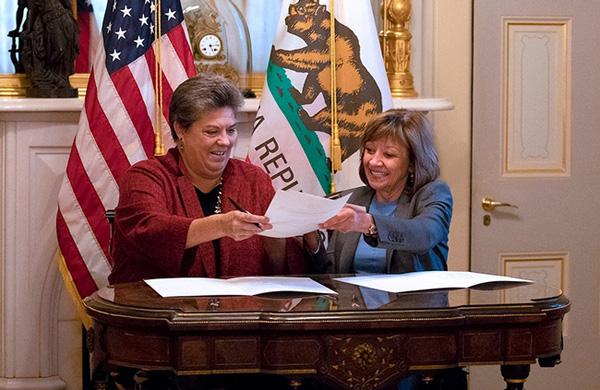
Glenda Humiston, Vice President of UC Agriculture and Natural Resources (left) and California Secretary of Agriculture Karen Ross sign a memorandum of understanding in the fall of 2018 to begin a new partnership advancing climate smart agriculture in California. Photo from CalCan
Note – CalCan is the California Climate and Agriculture Network
Technical assistance for farmers and ranchers is a critical tool for scaling up the widespread adoption of climate-beneficial agricultural practices. In the fall of 2018, University of California’s Division of Agriculture and Natural Resources (UCANR) launched a collaboration with the California Department of Food & Agriculture (CDFA) to provide technical assistance for CDFA’s Climate Smart Agriculture programs.
This year, with $1.1 million from the Strategic Growth Council, UCANR and CDFA deployed 10 UC Cooperative Extension (UCCE) Community Education Specialists to 10 counties across the state to partner with farmers to scale up climate smart agricultural practices on farms and ranches throughout California. See the contact list of Community Education Specialists. This is a helpful complement to the CalCAN-sponsored bill AB 2377 to scale up technical assistance for farmers and ranchers wanting to develop Climate Smart Agriculture projects.
UC Climate Smart Agriculture Team
To better understand the role of the CDFA-UCANR Climate Smart Agriculture team, CalCAN recently interviewed two of the UCCE Community Education Specialists, Britta Baskerville based in Mendocino County and Alli Rowe of Ventura County. We spoke to them about their work so far after several months in their positions, as well as the potential they see in these roles in the future.
In collaboration with Cooperative Extension and local Resource Conservation Districts (RCDs), the Community Education Specialists work to improve delivery of technical assistance to farmers and ranchers interested in Climate Smart agriculture. The new UC team will also assist with extension and outreach efforts, including farmer-to-farmer field days and train-the-trainer events.
“While we’re still just building relationships in our first year in these roles, we also get the benefit of leaning on the long history of Cooperative Extension’s relationships with growers in our community, which provides a depth of experience that helps us tailor our assistance in ways that are most meaningful and effective for our local community. These roles put us in a unique position to meet the needs of our local clients and the state goals at the same time,” Alli said.
Both Britta and Alli explained that they have been able to support other technical assistance providers in their communities, like RCDs and Natural Resources Conservation Service (NRCS), and add capacity to understaffed offices. Rather than a sense of competition between the different TA providers, there is one of collaboration. Ultimately, they have seen this result in the ability for the technical assistants to reach more growers in the community. Additionally, the ten Community Education Specialists can keep in constant communication throughout the CDFA Climate Smart Agriculture grant solicitation, acting as a team and relying on one another for support with questions.
Making the climate connection
Additionally, the positions’ specific nexus with climate change issues is helping to resource other providers to bring the climate lens into their work with growers.
Alli said, “For example, a Cooperative Extension advisor working with a farmer on a nutrient management plan to meet water regulation requirements can then come to me to discuss opportunities to adopt climate smart agriculture practices and use Healthy Soils funding to meet those goals.”
She added that she and her fellow Community Education Specialists have been able to demystify the state grant programs for growers, breaking down information and making it more accessible by doing things like tailoring lists of eligible practices specific to certain crops that growers in the community specialize in.
Alli explained that she is able to compile climate-related information and resources for other technical assistance providers while also rapidly scaling up farmer-to-farmer learning.
“Serving as a central hub of information and stories helps me share producers’ stories with other producers, speeding up the learning curve for producers and exposing growers in our community to feasible practices for their operations that may fall outside of the mainstream or current common understanding of what can work for their operations,” she said.
Technical assistance making a difference
In the recent Healthy Soils Program award announcements, almost every project that Britta and Alli assisted with were funded, amounting to ten total projects that include a demonstration project in Ventura County. However, they both know that the impact of their work extends beyond the promising initial success rate, and even beyond direct ties to CDFA funding. While many growers do need incentive funding to make their projects work on the ground, Alli is working with a grower interested in implementing cover cropping systems without formally applying for funding through the Healthy Soils Program to do so.
Similarly, Britta is working with a grower who is enthused about implementing several climate smart practices in his vineyard even though the scope of his project is currently incompatible with CDFA guidelines. Britta is committed to working with him to figure out how to best resource him to make it happen.
Moving forward, both Specialists see a lot of potential for their roles. Britta is currently working with the Mendocino RCD to develop a protocol for demonstration projects through the Healthy Soils Program, which she knows the community is interested in, but wasn’t prepared to apply for in the last round of funding.
“There’s so much potential for climate smart agriculture here. There is a high level of interest from farmers. It’s more a matter of helping them find pathways to success to implement these practices,” Britta said. “I’m looking forward to my role in assisting with implementation of these projects, as well as continuing to build relationships with growers, many of whom were interested in applying for CDFA grants but not yet ready to do so this year.”



4 Responses to UC Climate Smart Ag Team (including CDFA) showing results – from CalCan